I’ve posted a recipe for lobster risotto before, a very elegant dish with a mild lobster flavor in the risotto itself. That version requires 1 lobster (of about 650 grams or 1.5 lbs) for every two servings. If you like it more decadent and with a bold lobster flavor, this lobster bisque risotto is the recipe for you. It requires the double amount of lobster, i.e. 1 lobster per serving. This means you can make more lobster stock, and then reduce it to concentrate its flavor. Such concentrated lobster stock is called bisque, hence the name of this recipe. To add even more flavor, the lesser pieces of the lobster meat and the tomalley are pureed and added to the risotto. The nice pieces of lobster meat including the tail are served on top.
The result is a flavor bomb with great depth of flavor. This is a wonderful dish for a special occasion. The portion shown in the photo is half a portion with half of a lobster, as I served it as part of a larger menu.
In terms of ingredients the recipe is quite simple. You just need lobsters, some vegetables for the stock, and the usual ingredients for risotto. In the recipe below I use two pieces of equipment you may not have: a pressure cooker and a sous-vide. Although using this equipment will improve the texture and flavor of the dish, it is possible to make a good version without them. I will provide alternative instructions below. In the recipe below I use live lobsters and show how to handle them. You could substitute with a whole frozen lobster (which is usually already cooked) if you can’t obtain live lobsters, but the flavor will suffer from it. Frozen lobster tails are no good, because you will need the lobster bodies to make the stock.
Ingredients
For 2 large or 4 small servings
2 live lobsters of about 650 grams (1.5 lbs) each
130 grams (2/3 cup) risotto rice, such as carnaroli
80 ml (1/3 cup) dry white wine
3 Tbsp butter, divided
salt and freshly ground black pepper
1 shallot, minced
1 onion, 1 celery stick, 1 carrot, chopped
fresh thyme and parsley
1/2 tsp black peppercorns
1 bay leaf
2 tsp tomato paste
freshly squeezed lemon juice
2 Tbsp olive oil
Preparation
Put the lobster in the freezer for 10 minutes or so to make them drowsy. Bring a large pot with 2 litres (2 quarts) of water to a boil.
Put the tip of a large chef knife on the ‘cross’ on the head of the lobster.
Thrust the knife down and forward to kill the lobster instantly. (It will keep moving, but those are just spasms.)
Separate the lobster into tail, legs, claws, and body.
Cut open the body and take out the tomalley (that is the squishy greenish stuff). Put it in a bowl. Get rid of the other stuff that is inside the body, as it will give the lobster stock a bitter taste.
Repeat with the second lobster.
Cover and refrigerate the bowl with the tomalley.
Put the tails, legs, and claws into the pot once the water boils. Bring it back to a boil, then turn off the heat.
If using sous-vide, lift the tails out after 1 minute and plunge them into cold water to stop the cooking.
Allow the claws and legs to steep in the hot water for about 7 minutes longer. (If not using sous-vide, leave the tails in for the same amount of time.)
Meanwhile, take the lobster meat out of the tails. Since I was doing 4 small portions, I simply used a chef knife to cut each tail in half lengthwise.
When doing 2 portions, cut the tail open with scissors and try to keep the tail meat whole.
Reserve the shells.
Once the claws and legs have finished steeping, life them out of the hot water and plunge them in the cold water as well. Reserve the hot water in which the lobster has steeped, as that will become the stock!
Take the meat out of the claws. Separate the tips from the nicer main claw meat. Reserve the shells.
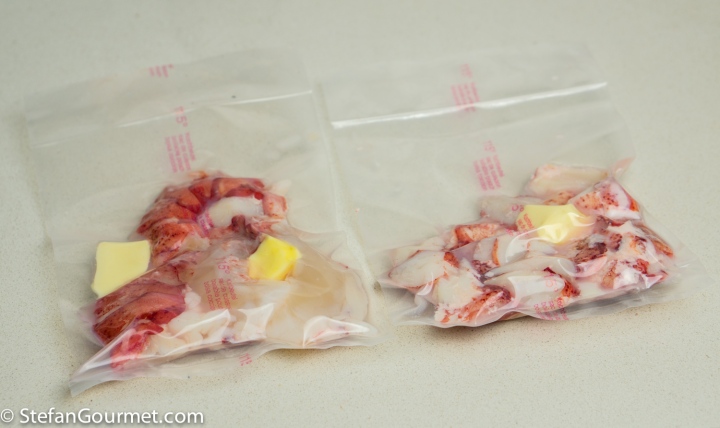
If using sous-vide, vacuum seal the lobster tails and lobster claw meat with a tablespoon of butter, and refrigerate.
(If not using sous-vide, put the tails and claw meat in a bowl, cover, and refrigerate.)
Take the meat out of the legs with a rolling pin (read how to do that in this post). Put the meat from the legs and the claw tips into a bowl, cover the bowl and refrigerate.
Heat two tablespoons of olive oil in a large casserole over medium-high heat. Add all of the lobster shells (bodies, claws, legs).
Stir over medium-high heat until the shells have obtained a red color all over. Turn off the heat.

Chop a carrot, an onion, and a stick of celery.
Put the carrot, onion, and celery in the hot water in which the lobster was steeping. Add the lobster shells, a bay leaf, a sprig of parsley, a sprig of thyme and 1/2 teaspoon of black peppercorns.
If using a pressure cooker, pressure cook the lobster stock for 30 minutes.
(If not using a pressure cooker, bring to a boil, and simmer for an hour.)
The pressure cooker will extract more flavor from the lobster shells, but traditional simmering will provide good results as well.
Strain the stock first with a colander…
…and then with a fine sieve.
Put the lobster stock in a wide pan and bring to a boil, then reduce to a simmer.
Simmer the stock until has been reduced to about 700 ml (about 3 cups).
Everything up to here is preparation that can be done earlier on the same day. You could also cook the risotto until it is almost done and the reheat it when it becomes time to serve, but for the best texture risotto should be made right before it is eaten.
To start making the risotto, melt 2 tablespoons of butter in a wide thick-bottomed pan. Add a mince shallot and stir over low heat for a couple of minutes until the shallot is translucent.
Meanwhile, if using sous-vide, put the lobster meat that you vacuum sealed previously in a sous-vide cooker at 46C/115F. (This is my favorite texture for lobster tails. For a more traditional texture, use 60C/140F.)
Make sure the lobster stock is hot.
When the shallot is translucent, add 130 grams (2/3 cup) risotto rice.
Stir over medium heat until the rice is very hot.
Add 80 ml (1/3 cup) dry white wine, and stir over medium heat until it has evaporated.
Add a ladle of hot lobster stock, and stir.
Add 2 teaspoons of tomato paste, and stir to incorporate.
Add a ladle of hot stock. Stir over medium heat until the stock has been absorbed by the rice. As soon as it has been absorbed, add another ladle of stock. Keep stirring and adding stock until the rice is cooked al dente, about 15-18 minutes.
When you have only about 125 ml (1/2 cup) of stock left, add the tomalley, claw tips and leg meat, and puree with an immersion blender.
Add this mixture to the risotto.
Taste and adjust the seasoning with salt and freshly ground black pepper. When the risotto is cooked to your liking, turn off the heat, cover and allow the risotto to rest for a couple of minutes.
The risotto is cooked when the grains of rice are cooked but still have some bite to them (that is what al dente means; dente = tooth).
If using sous-vide, take the lobster meat out of the sous-vide.
Cut the bags open and pour the butter and lobster juices into the risotto.
(If not using sous-vide, add a tablespoon of butter, cut into small pieces, to the risotto, and stir until the butter has melted.)
Add some freshly squeezed lemon juice to taste. This only serves to brighten up the flavor a little. By adjusting the amount of lemon juice, you can make sure the risotto will work with the acidity of the wine that you selected to go with the dish.
Heat up the lobster pieces in a non-stick frying pan over medium heat. (You could also heat them up on top of the hot risotto. That is in fact preferable when not using sous-vide, as heating them up in the frying pan from the refrigerator will dry out the lobster too much.)
Serve the risotto on preheated plates and top with the lobster pieces.
Wine pairing
Such a special dish asks for a special wine. Make sure to buy the most expensive bottle of aged white Burgundy (preferably Le Montrachet, but Puligny-Montrachet, Chassagne-Montrachet or Meursault are more affordable alternatives) you can afford for a true feast! Another oaked chardonnay (for instance from California) could work, too, but it probably won’t have the complexity of a good white Burgundy.
Flashback
Duck breast can be perfected by cooking the meat and skin separately and gluing them together. That way you can have thin crispy skin without overcooking the meat.

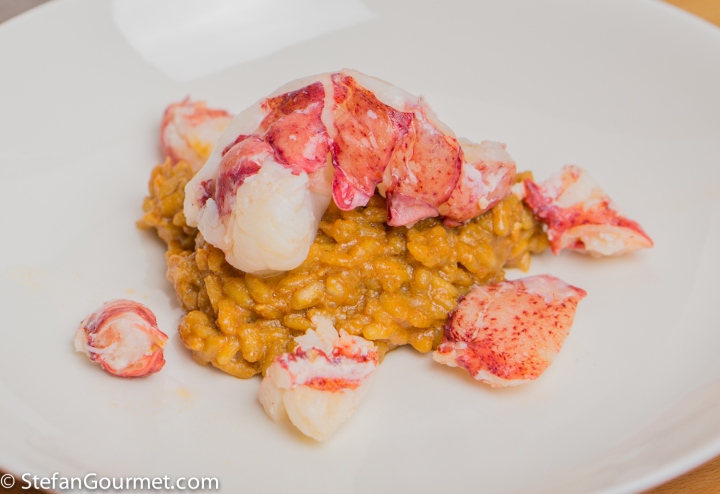

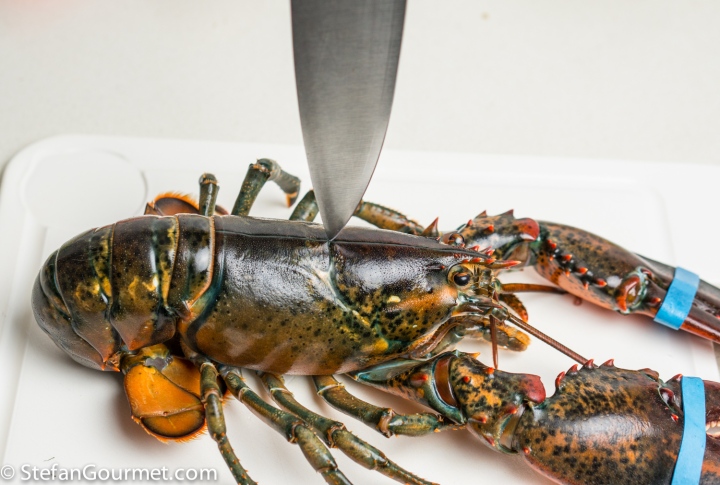

















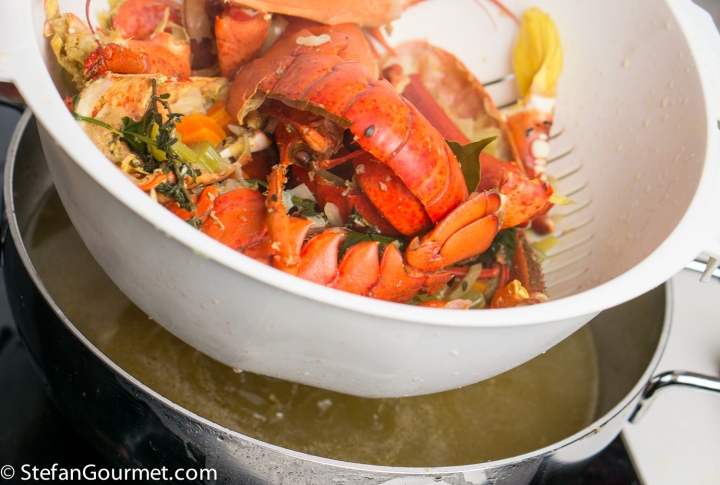



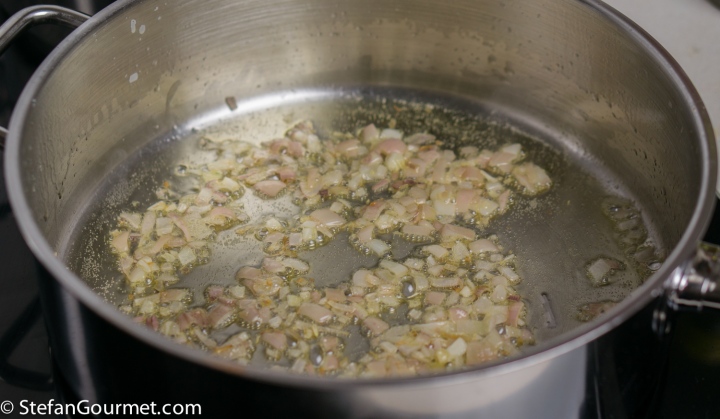

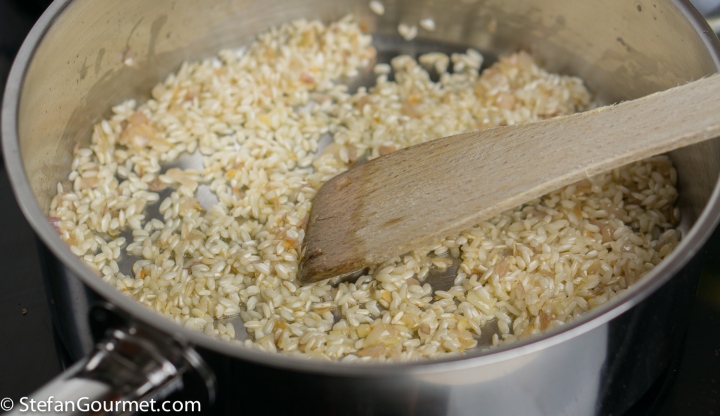

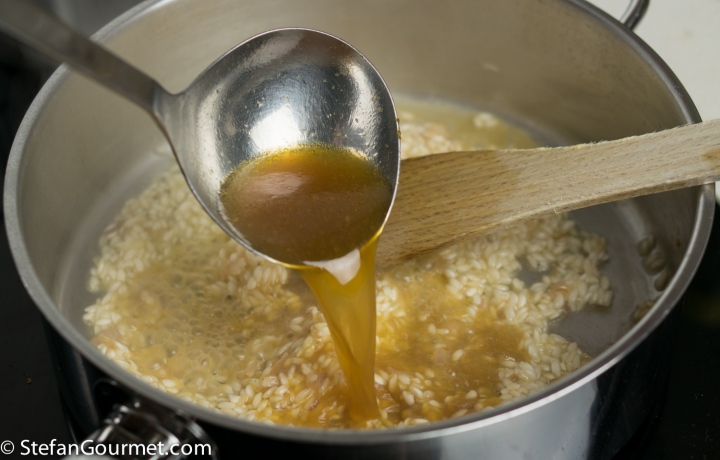

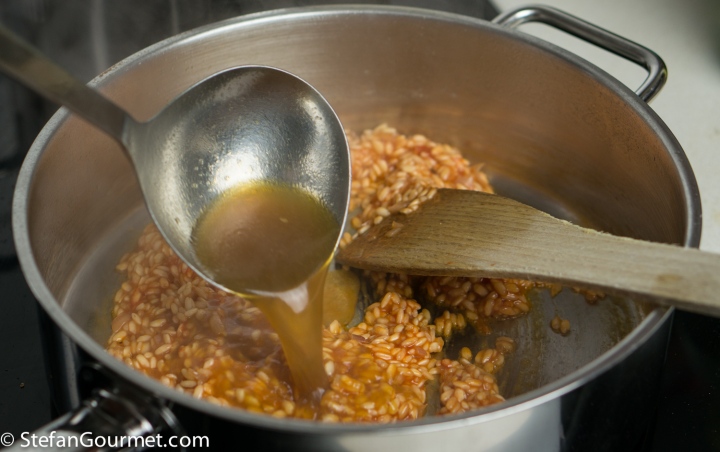

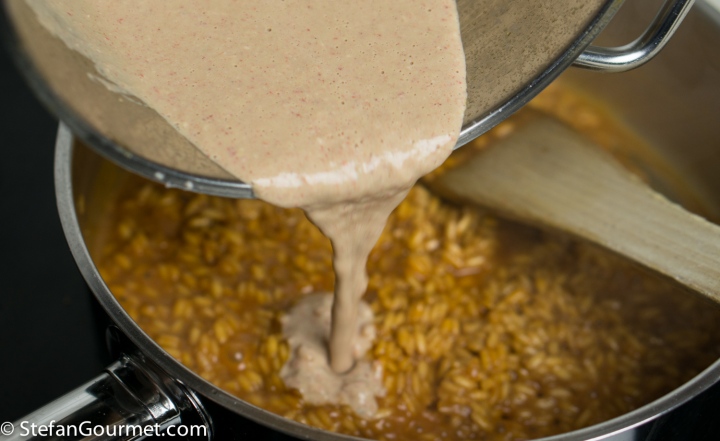

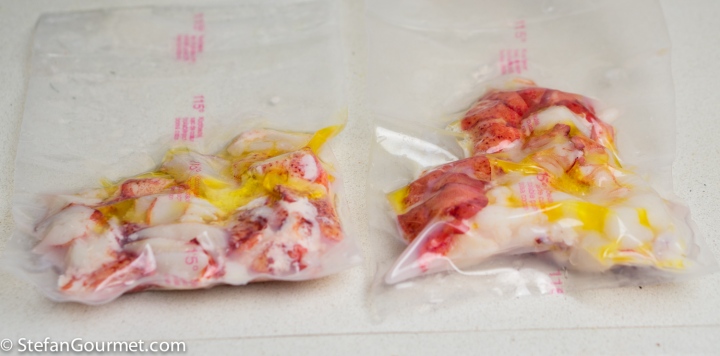


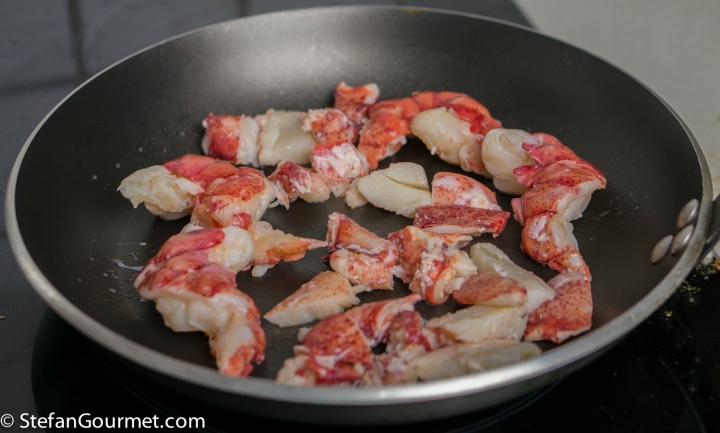
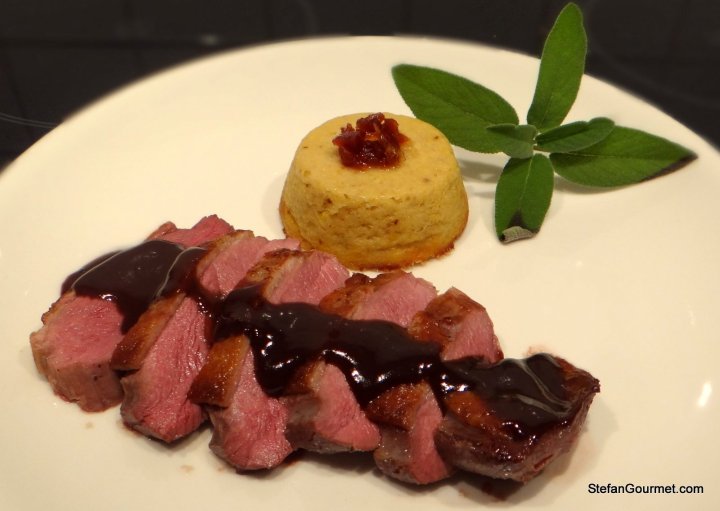

amazing many lobsters on blogs today.
LikeLike
now that does look nice! Got to give that a go.
LikeLiked by 1 person
What happened to the Tomalley.. did that go in the same bowl as the small pieces of lobster meat?
LikeLiked by 1 person
Yes, it gets pureed together with the claw tips and leg meat and added at the end. I had forgotten to mention the tomalley in that step — fixed that now. Thanks for pointing it out!
LikeLike
I would have loved to been at this dinner! Sinfully delicious-looking. 🙂
LikeLiked by 1 person
The dinner was indeed delicious 🙂
LikeLiked by 2 people
I love lobster but the big $$$$$ make it a special occasion treat, sigh.
LikeLike
This is certainly a dish for special occasions, especially if you get a good bottle of white Burgundy to drink with it as well.
LikeLiked by 1 person
*smile* No sous-vide, pressure cooker or live lobsters here in the country, but love both the ‘critters’ and risotto and this looks fantastic . . . so guess which recipe has just ended up on top of the kitchen ‘to do’ pile . . . I freeze my lobsters for longer, do away with the ‘grizzly’ bit and plunge them straight into boiling water . . . supposedly they don’t suffer that way either . . .
LikeLiked by 1 person
When you aren’t going to cook them sous-vide anyway, that method is certainly easier.
I’ve prepared live marron in Australia, that could be a good substitute!
LikeLike
Buono, elegante, perfetto per le feste natalizie
LikeLiked by 1 person
Very elegant indeed. I must get a couple of lobster over the break and give something like this a whirl. I still remember the lobster we cooked together three years ago. Delicious!.
LikeLiked by 1 person
Are there any lobsters in Irish coastal waters? Most of the lobsters we get here are from Canada. Dutch lobsters are only available for 10 weeks in spring.
LikeLiked by 1 person
Plenty on the east coast. Not so many on the west.
LikeLiked by 1 person
Stefan, how do the Canadian lobsters taste? I was always under the impression that imported lobster and crab are flavorless since they aren’t fed after being pulled from the water, but I’ve never tested that impression! It’s also possible that the starving crustacean thing only applies to the American market. I now live on the west coast of the US where I no longer have access to fresh lobster, and I assumed my only real option was buying precooked lobsters from the east coast. Do you happen to know if Canadian lobsters purchased in the Netherlands are fed at some point? If they’re not, that’s great news for me since I certainly trust your palate.
LikeLike
Hi David, I was curious about whether lobsters are fed myself and asked my fishmonger about this. The lobsters here are not fed. According to the fishmonger, they can go without food for at least 6 weeks. The Canadian lobsters taste just fine. I don’t think starving them will reduce their flavor, it might reduce the yield of lobster meat somewhat though. I’ve once compared a Canadian lobster to a local lobster, which is twice as expensive and supposed to be better tasting. I could detect a difference, but think it is a matter of personal taste which one you prefer. I thought the Canadian lobster was slightly sweeter, which I like.
I am sure that a freshly cooked live lobster, even after starving it, will have more flavor than a frozen precooked lobster.
LikeLike
Stefan, thanks for your reply. That’s great to hear!
LikeLiked by 1 person
A lot of steps but the risotto is definitely worth it! Wish I could have some now!
LikeLiked by 1 person
Hi Stefan.
I did lobster and scallops sous vide last year for New Years eve. This year I’ll go for this risotto. Great recipe
LikeLiked by 1 person
Thanks! Would love to hear how it turns out.
LikeLike
Happy New Year,
I did a Lobster Bisque Risotto for starter yesterday and it turned out very successful. The guests where very happy with the dish.
I did som alterations to your recipe, based on my own experience making bisque and my previous takes on butter poached lobster. My guests prefer the lobster cooked a bit warmer, at 50,5 degrees.
You can check out the result on my blog
My best regards,
Stig
LikeLiked by 1 person
Ottimo, ottimo, ottimo! 🙂
LikeLiked by 1 person
Not only did you sneak in sous-vide, Stefan, but you tossed in the pressure cooker, too. A real two-fer! Even so, this dish does sound wonderful. It it definitely a dish for special occasions and what an impression it would make. It’s another masterpiece from your kitchen.
LikeLiked by 1 person